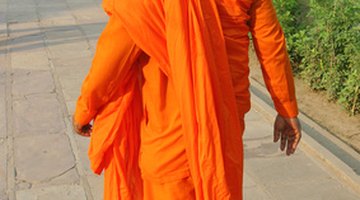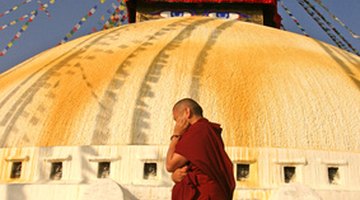Buddhist traditions emphasise attention to the present moment. When Buddhist monks apply that world view to their garments, monks intently focus on the right folding procedure. For Buddhist monks, folding means more than neatly folding for storage. Folding refers to how a Buddhist monk wears his robe. A Buddhist monk's robe may be comprised of several robes with folds symbolising the Buddhist tradition to which the monk belongs. Buddhist monks may prepare robes known as uttarasanga, antaravasaka and sanghati.
- Buddhist traditions emphasise attention to the present moment.
- A Buddhist monk's robe may be comprised of several robes with folds symbolising the Buddhist tradition to which the monk belongs.

Fold the uttarasanga, considered a Buddhist monk's clerical robe. The uttarasanga is a six-by-nine-foot piece of cloth. This is the part of a Buddhist monk's robe known as the kashaya robe. According to the website Urban Dharma, you should wrap this rectangular cloth around your upper body, folding the material so it drapes over one or both shoulders. Fold the robe or pleat it into five vertical columns that hang to your feet.

Fold the extra robe, the sanghati. Frequently made of two layers, Buddhist monks may use the sanghati as an over-robe or as portable bedding. Fold the sanghati into a small square to carry it on your shoulder.
Prepare the lower robe, called the antaravasaka, or sabong. Wrap this part of the robe around your waist so it extends to your knees. Urban Dharma explains that the sabong is worn folded like a sarong and held in place at the waist by a cotton belt.
